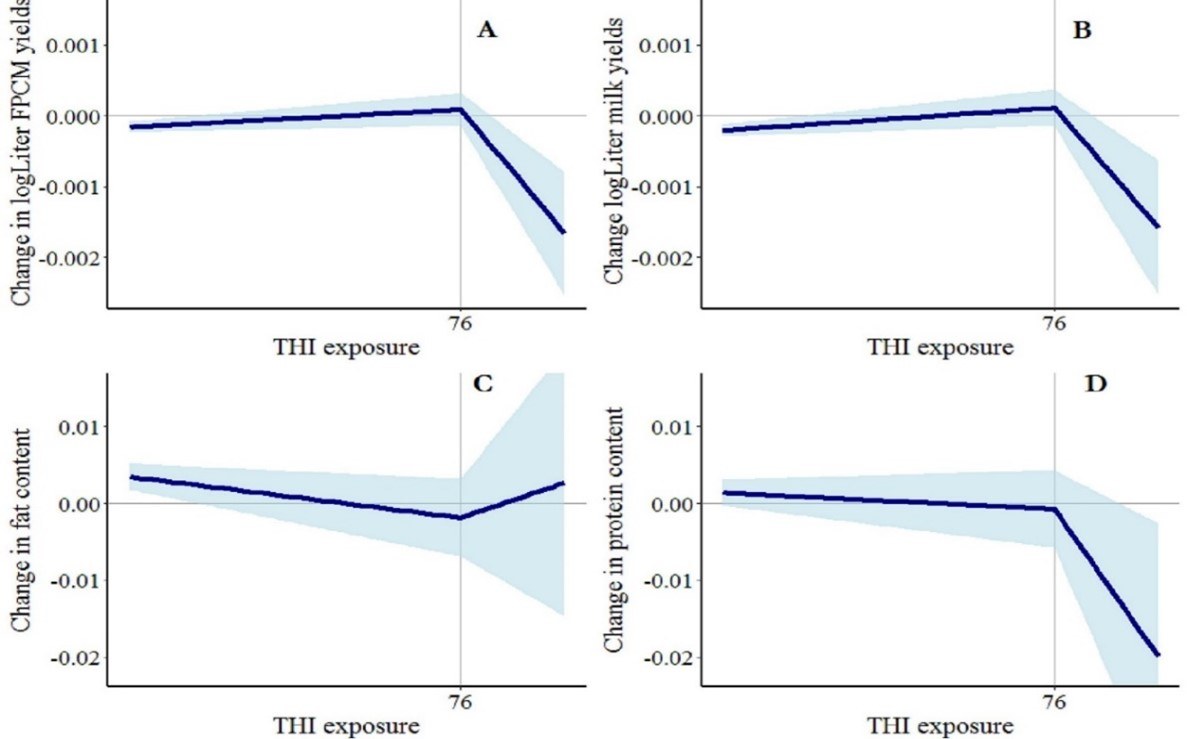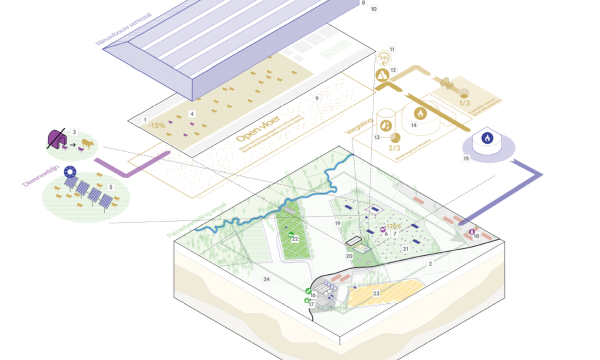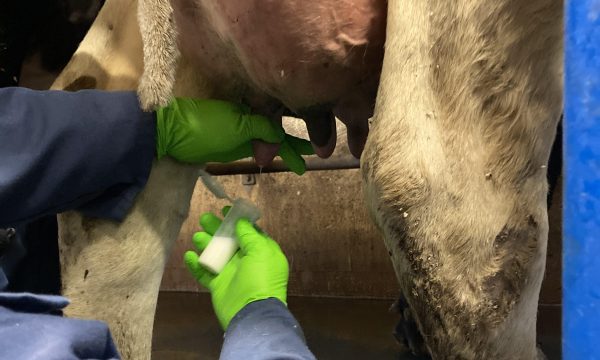Press release Dairy farm losses from heat waves quantified
Agricultural economists juxtaposed long-term production figures from all Flemish dairy farms with recorded weather events to assess the economic damage caused by heat. Heat can have a clear negative impact on the amount of milk cows give, and on milk composition. As it turns out. 'There is quantifiable economic damage that can reach €1500 and more per month per farm,' says ILVO agricultural economist Erwin Wauters. 'The effect of hot, oppressive summer days on the cow and her milk production is not linear. A clear nod to heavier economic damage lies at 76 points on the so-called THI scale (Temperature Humidity Index).'
ILVO collaborated with the Agricultural Economics and Policy Group at ETH Zurich (Switzerland) for this study. 'We now know from which heat point and severity yield losses occur, and up to which heat point dairy farmers can manage or reduce the risk of negative effects with current anti-heat stress techniques.'
Flemish dairy farming as a case study
High temperatures and high humidity affect milk quantity and milk quality (e.g., fat and protein content), every dairy farmer knows that intuitively. Now the size and course of the economic damage caused by heat has been calculated.
The researchers released their calculations on nearly 180,000 unique monthly data on milk quantity and quality at farm level, from all dairy farms in Flanders for 6 years (N = 178,843; years 2009-2015). This dataset on dairy production was matched with high-resolution weather data, more specifically with the so-called Temperature Humidity Index (THI). Some results nuance findings from smaller-scale experimental heat studies.
Econometric methodology
Using fixed effects regression, the study focused on heat shocks, i.e. the deviations from the average climate at the specific location of each dairy farm, on production shocks, i.e. deviations from the average production of the farm. The researchers used nonlinear restricted cubic splines regression to estimate the response of milk quality and quantity to hourly Temperature Humidity Index (THI) exposure. The analysis allowed for evidence of the true effects of exposure to extreme heat for a highly representative population of farmers.
€1500 per farm per month observed
Heat shocks (sudden onset of warm and humid conditions) lead to a decrease in milk quantity and protein content in the cow. Milk fat content seems to be unaffected, if at all. That milk fat is unaffected by heat, and even more likely to increase above a certain heat threshold, contradicts previous experimental work, and it shows that at least on this indicator, heat effects are resisted longer.
The effects observed are of considerable economic importance. In the month with the most extreme THI values, an average farm loses nearly 5% in milk production. For an average farm and an average price of 30 euro cents per liter this amounts to a loss of 440 euros for that month, for the 5% worst affected farms in that month it is more than 1500 euros. This economic impact does not yet take into account any increased costs during that period.In recent years, the number of heat waves is increasing each year. From a simulation calculation, the researchers conclude that each extra day with a THI of 85 (corresponding, for example, to a temperature of 33°C and a relative humidity of 65%) on an average dairy farm and at an average milk price can lead to a loss of revenue of 500 euros.

When does heat become harmful?
The critical THI (Temperature Humidity Index) threshold above which exposure leads to sharp reductions in milk quantity and milk protein contents is generally higher than previous experimental studies suggest. It is clear (see graph) that above a THI of 76 there is a steep decline in milk parameters (except fat content).
Farmers can successfully reduce heat stress in their cows, and the negative effects of heat shocks in the barn or pasture through anti-heat measures, albeit only partially. Possible strategies include ventilation, water misting in the barn, providing enough drinking water at an optimal temperature, grazing at the coolest times of the day or modifications to the dairy herd.Erwin Wauters (ILVO): 'We see that there is a THI limit above which anti-heat stress measures are no longer able to neutralize yield losses.'
Future
Across the entire period studied in which data was available, namely 2009-2015, the economic impact was still somewhat limited, as very high THI values were not as frequent yet. However, the economic importance of heat stress on dairy farms is significant and still growing, due to increasing climate change. In the more recent period, days with high THI values have been much more frequent.
The dataset of this study did not allow the evaluation of anti-heat stress measures and strategies present or absent among individual farmers for their economic efficiency. More research on anti-heat stress measures in dairy cattle and their cost-benefit balance are useful and needed.The effects identified here are relevant to the dairy industry, as heat waves, which tend to occur throughout the region, can lead to significant fluctuations in milk quantity and quality. It is also good for policy to know to what extent the farm can be supported (e.g., through education and financial support) and what other risk management tools (e.g., weather insurance) make sense.
Finally, this type of research shows the value of using data from the field to supplement experimental data, since studies under experimental conditions do not take into account any adjustments made by the farmer.
Flemish practical knowledge about heat stress in cows and possible defense against it
ILVO and partners are actively researching heat management strategies. Farmers can find the research results on the website of the ILVO cattle databank.: Hittestress, wat doet het met een koe? | RUNDVEELOKET. Recently, educational articles and videos have also been created within the research project 'first aid for heat stress cow': Ventilatoren als hulpmiddel in de strijd tegen hittestress bij runderen
Watertechnieken bij erge hittestress: Welke mogelijkheden zijn er?
Broeiremmers gebruiken tijdens periodes van hittestress
Preventie van hittestress: kosten en opbrengsten van verschillende technieken in beeld
Contact and links (in Dutch)
Greet Riebbels, ILVO communication greet.riebbels@ilvo.vlaanderen.be M. +32 486 26 00 14
Dr. Erwin Wauters, ILVO expert in ag economics erwin.wauters@ilvo.vlaanderen.be T. +32 9 272 23 47
Co-authors of the study: Willemijn Vroege, Robert Finger and Tobias Dalhaus
Tobias Dalhaus op X: 'ICYMI: New paper in @AGSY_Journal on the impact of heat on dairy production based on a huge dataset from Belgium Results suggest that farmers are at least partly able to manage impacts with: Willemijn Vroege, @WautersErwin, & @RobertFinger1
👉https://t.co/C6v2D1oQwW https://t.co/mXGtxVgD3j' / X (twitter.com)
Robert Finger op X: 'Effects of extreme heat on milk quantity and quality New @aecp_eth paper led by @willemijnvroege with @tobi_dal and @WautersErwin published in Agricultural Systems. Contribution to @surefarmproject https://t.co/mpSARH3xh0 https://t.co/XEn4gaiWjG' / X (twitter.com)
Tobias Dalhaus op X: '"Heat affects dairy farms in Belgium economically, but less than previously thought" new @WUReconomic blog with @RobertFinger1 @WautersErwin and Willemijn Vroege blog 👉https://t.co/cSBOjtMohC paper 👉https://t.co/C6v2D1oQwW https://t.co/XASOanRGFI' / X (twitter.com)
Robert Finger op X: 'Hitze schädigt Milchviehbetriebe, aber weniger als bisher angenommen Neuer @aecp_eth #Agrarpolitik-Blog mit @tobi_dal @WautersErwin & W. Vroege https://t.co/WMIAZhzp1x' / X (twitter.com)


